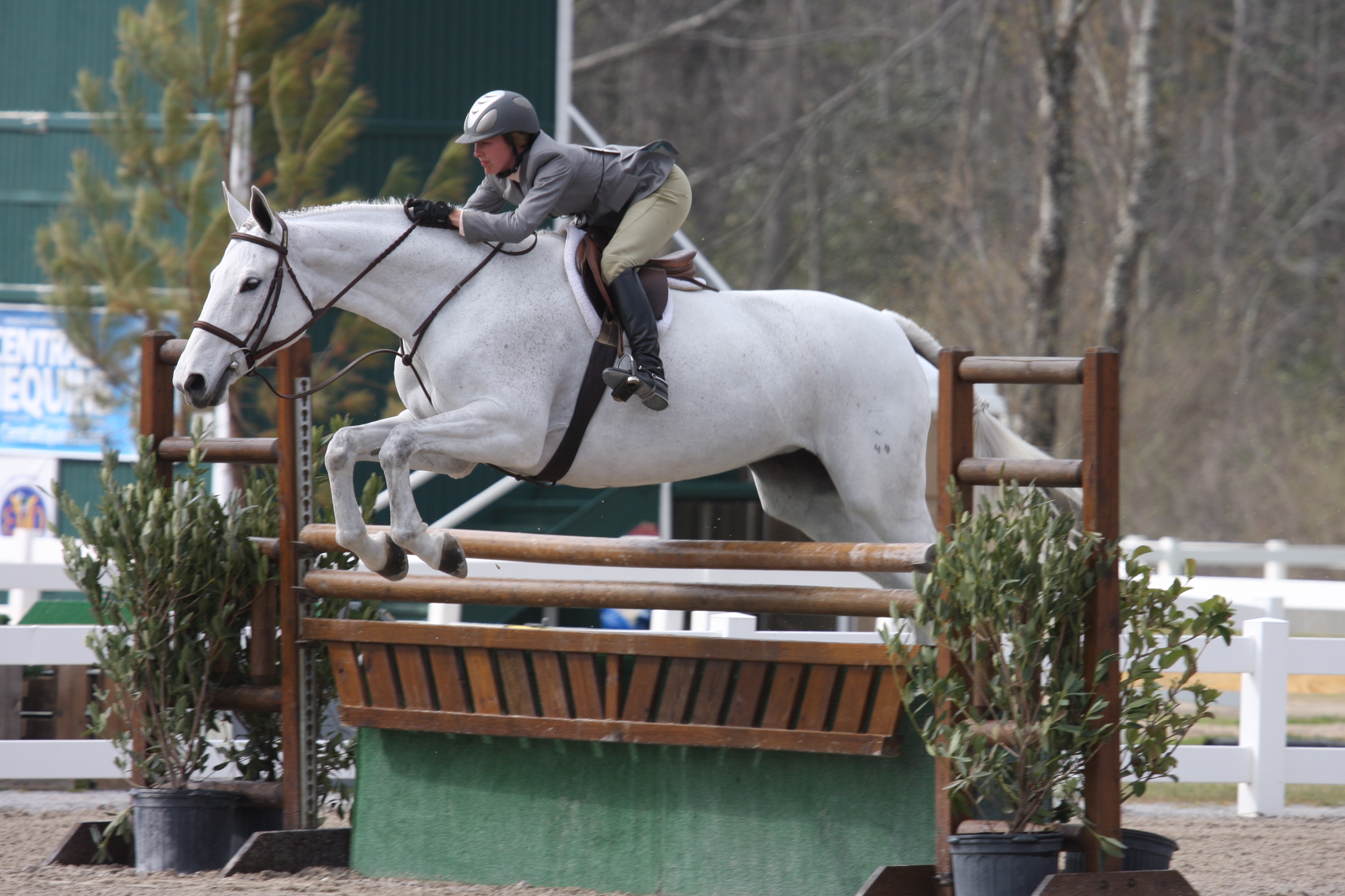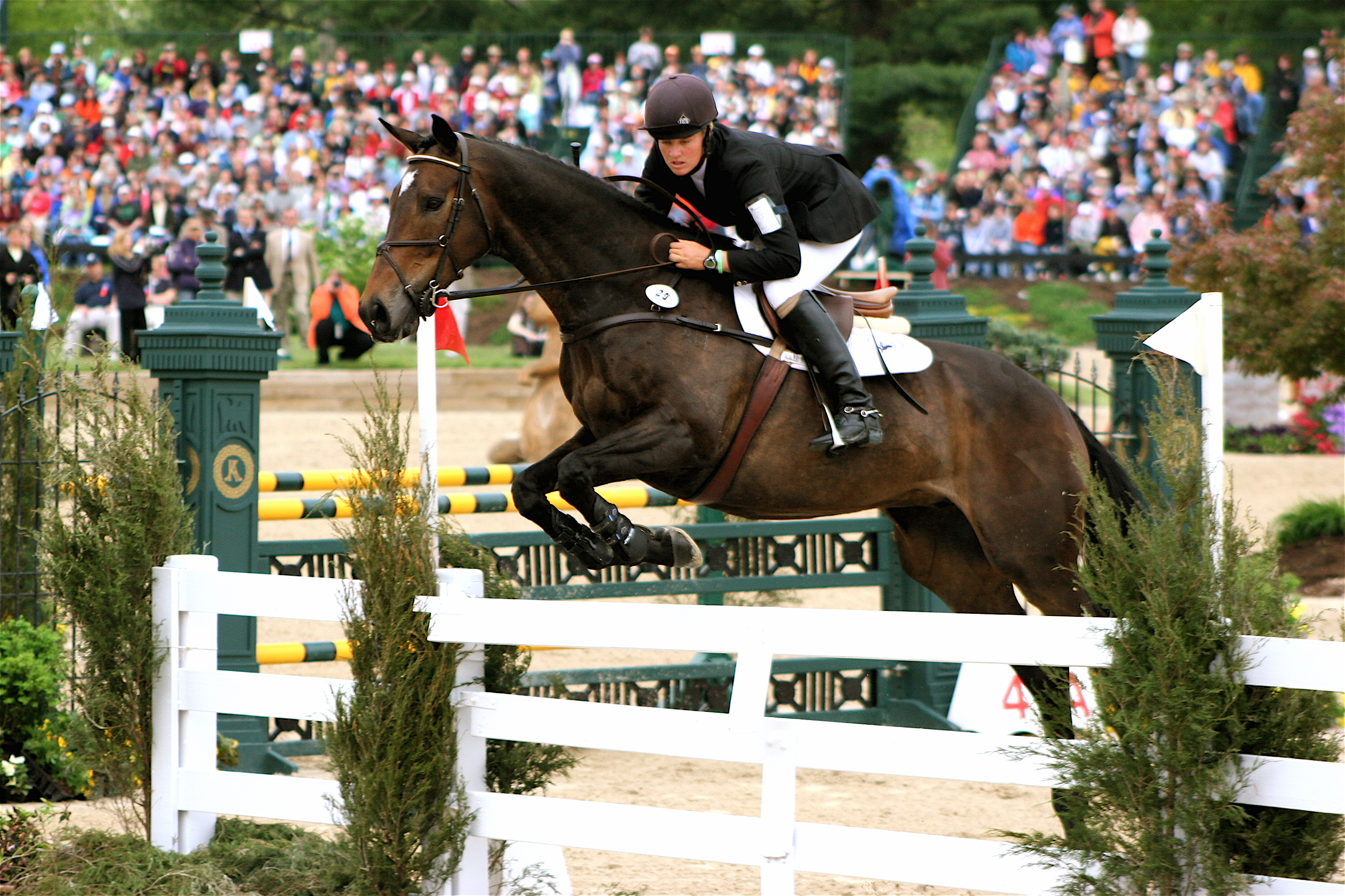|
Cavesson
A noseband is the part of a horse's bridle that encircles the nose and jaw of the horse. In English riding, where the noseband is separately attached to its own headstall or crownpiece, held independently of the bit, it is often called a cavesson or caveson noseband. In other styles of riding, a simple noseband is sometimes attached directly to the same headstall as the bit. Development A noseband may have been one of the first tools used by humans to domesticate and ride horses. The bit developed later. The noseband was originally made of leather or rope. After the invention of the bit, the noseband was, in some cultures, demoted to a halter worn beneath the bridle that allowed the rider to remove the bit from the horse's mouth after work and leave a restraining halter on underneath, or to tie the horse by this halter, instead of by the bit, which could result in damage to the horse's mouth if it panicked. However, its ability to hold a horse's mouth shut over the bit was also ... [...More Info...] [...Related Items...] OR: [Wikipedia] [Google] [Baidu] |
Longeing Cavesson
A longeing cavesson (UK English: lungeing) is a piece of equipment used when longeing a horse. A longeing cavesson consists of a heavy, padded noseband, metal rings to attach the longe line, a throatlatch, and sometimes additional straps such as a jowl strap or a browband for added stability. It is placed on the horse's head in a manner somewhat akin to a halter, but provides significantly more control than a halter, without placing pressure on the horse's mouth as a bridle would. The noseband should be just below the cheekbone, several inches above the nostrils sitting on the nasal bone, and fitted snugly. The jowl strap should be very snug to prevent the cavesson from slipping into the horse's eye. The key feature of a longeing cavesson is the strategic placement of rings for varying places to attach the longe line: one at the top of the nasal bone and one each side of the noseband. Many other types of headgear may be used for longeing, but the longeing cavesson is most commo ... [...More Info...] [...Related Items...] OR: [Wikipedia] [Google] [Baidu] |
Bridle
A bridle is a piece of equipment used to direct a horse. As defined in the ''Oxford English Dictionary'', the "bridle" includes both the that holds a bit that goes in the mouth of a horse, and the reins that are attached to the bit. Headgear without a bit that uses a noseband to control a horse is called a hackamore, or, in some areas, a bitless bridle. There are many different designs with many different name variations, but all use a noseband that is designed to exert pressure on sensitive areas of the animal's face to provide direction and control. Parts The bridle consists of the following elements: * Crownpiece: The crownpiece, headstall (US) or headpiece (UK) goes over the horse's head just behind the animal's ears, at the poll (livestock), poll. It is the main strap that holds the remaining parts of the bridle in place. * Cheekpieces: On most bridles, two cheekpieces attach to either side of the crownpiece and run down the side of the horse's face, along the cheekb ... [...More Info...] [...Related Items...] OR: [Wikipedia] [Google] [Baidu] |
Hackamore
A hackamore is a type of animal headgear which does not have a bit. Instead, it has a special type of noseband that works on pressure points on the face, nose, and chin. Hackamores are most often seen in western riding and other styles of riding derived from Spanish traditions, and are occasionally seen in some English riding disciplines such as show jumping and the stadium phase of eventing. Various hackamore designs are also popular for endurance riding. While usually used to start young horses, they are often seen on mature horses with dental issues that make bit use painful, and on horses with mouth or tongue injuries that would be aggravated by a bit. Some riders also like to use them in the winter to avoid putting a frozen metal bit into a horse's mouth. There are many styles, but the classic hackamore is a design featuring a '' bosal'' noseband, and sometimes itself called a "bosal" or a "bosal hackamore". It has a long rope rein called a mecate and may also ad ... [...More Info...] [...Related Items...] OR: [Wikipedia] [Google] [Baidu] |
Saddle Seat
Saddle seat is a style of horse riding within the category of English riding that is designed to show off the high action of certain horse breeds. The style developed into its modern form in the United States, and is also seen in Canada and South Africa. To a much lesser extent, it is ridden with American horse breeds in Europe and Australia. The goal of the saddle seat riding style is to show off the horse's extravagant gaits, particularly the trot. It is not to be confused with the various hunt seat disciplines. History Saddle seat riding began as a distinct style within the broader group of English riding disciplines developed in the United States. The first source was the Plantation tradition of the American South, where smooth-moving, high-stepping horses were used by plantation owners and overseers to travel across the fields. The horses had to be smooth riding and comfortable enough for hours of riding while overseeing the plantation, but the owners also preferred an i ... [...More Info...] [...Related Items...] OR: [Wikipedia] [Google] [Baidu] |
Eventer Head
Eventing (also known as three day eventing or horse trials) is an equestrian event where a single horse and rider combine and compete against other competitors across the three disciplines of dressage, cross-country, and show jumping. This event has its roots in a comprehensive cavalry test that required mastery of several types of riding. The competition may be run as a one-day event (ODE), where all three events are completed in one day (dressage, followed by show jumping and then the cross-country phase) or a three-day event (3DE), which is more commonly now run over four days, with dressage on the first two days, followed by cross-country the next day and then show jumping in reverse order on the final day. Eventing was previously known as Combined Training, and the name persists in many smaller organizations. The term "Combined Training" is sometimes confused with the term "Combined Test", which refers to a combination of just two of the phases, most commonly dressag ... [...More Info...] [...Related Items...] OR: [Wikipedia] [Google] [Baidu] |
Dressage
Dressage ( or ; a French term, most commonly translated to mean "training") is a form of horse riding performed in exhibition and competition, as well as an art sometimes pursued solely for the sake of mastery. As an equestrian sport defined by the International Equestrian Federation, dressage is described as "the highest expression of horse training" where "horse and rider are expected to perform from memory a series of predetermined movements." Competitions are held at all levels from amateur to the Olympic Games and World Equestrian Games. Its fundamental purpose is to develop, through standardized progressive training methods, a horse's natural athletic ability and willingness to perform, thereby maximizing its potential as a riding horse. At the peak of a dressage horse's gymnastic development, the horse responds smoothly to a skilled rider's minimal aids. The rider is relaxed and appears effort-free while the horse willingly performs the requested movement. The disc ... [...More Info...] [...Related Items...] OR: [Wikipedia] [Google] [Baidu] |
Show Hunter
The Hunter division is a branch of horse show competition that is judged on the horse's performance, soundness and when indicated, conformation, suitability or manners. A "show hunter" is a horse that competes in this division. Show hunters, ideally, show many qualities that were rewarded in the fox hunting field such as manners, fluid movement, and correct jumping style. They are shown in hunt seat style tack. Any breed can be exhibited, but at the highest levels they are usually of Warmblood or Thoroughbred type, though a hunter-style pony is also seen in youth classes. Some classes are restricted to horses of certain breeds or height. In the United States, show hunters are primarily exhibited over fences in various divisions, including Green Hunter, Working Hunter, Conformation Hunter and so on, with a few additional classes offered for horses shown in-hand or on the flat, known as "Hunter Under Saddle." In the United Kingdom, competition over fences is called "Working Hun ... [...More Info...] [...Related Items...] OR: [Wikipedia] [Google] [Baidu] |
Hunt Bridle Head
Hunting is the human practice of seeking, pursuing, capturing, or killing wildlife or feral animals. The most common reasons for humans to hunt are to harvest food (i.e. meat) and useful animal products (fur/hide, bone/tusks, horn/antler, etc.), for recreation/taxidermy (see trophy hunting), to remove predators dangerous to humans or domestic animals (e.g. wolf hunting), to eliminate pests and nuisance animals that damage crops/livestock/poultry or spread diseases (see varminting), for trade/tourism (see safari), or for ecological conservation against overpopulation and invasive species. Recreationally hunted species are generally referred to as the ''game'', and are usually mammals and birds. A person participating in a hunt is a hunter or (less commonly) huntsman; a natural area used for hunting is called a game reserve; an experienced hunter who helps organize a hunt and/or manage the game reserve is known as a gamekeeper. Many non-human animals also hunt (see pred ... [...More Info...] [...Related Items...] OR: [Wikipedia] [Google] [Baidu] |
Field Hunter
Field may refer to: Expanses of open ground * Field (agriculture), an area of land used for agricultural purposes * Airfield, an aerodrome that lacks the infrastructure of an airport * Battlefield * Lawn, an area of mowed grass * Meadow, a grassland that is either natural or allowed to grow unmowed and ungrazed * Playing field, used for sports or games Arts and media * In decorative art, the main area of a decorated zone, often contained within a border, often the background for motifs ** Field (heraldry), the background of a shield ** In flag terminology, the background of a flag * ''FIELD'' (magazine), a literary magazine published by Oberlin College in Oberlin, Ohio * ''Field'' (sculpture), by Anthony Gormley Organizations * Field department, the division of a political campaign tasked with organizing local volunteers and directly contacting voters * Field Enterprises, a defunct private holding company ** Field Communications, a division of Field Enterprises * Field Museum ... [...More Info...] [...Related Items...] OR: [Wikipedia] [Google] [Baidu] |
Show Jumping
Show jumping is a part of a group of English riding equestrian events that also includes dressage, eventing, hunters, and equitation. Jumping classes are commonly seen at horse shows throughout the world, including the Olympics. Sometimes shows are limited exclusively to jumpers. Sometimes jumper classes are offered in conjunction with other English-style events. Sometimes, show jumping is but one division of a very large, all-breed competition that includes a very wide variety of disciplines. Jumping classes may be governed by various national horse show sanctioning organizations, such as the United States Equestrian Federation or the British Showjumping Association. International competitions are governed by the rules of the International Federation for Equestrian Sports. Hunters or jumpers Show jumping events have hunter classes, jumper classes and hunt seat equitation classes. Hunters are judged subjectively on the degree to which they meet an ideal standard of man ... [...More Info...] [...Related Items...] OR: [Wikipedia] [Google] [Baidu] |

.jpg)


